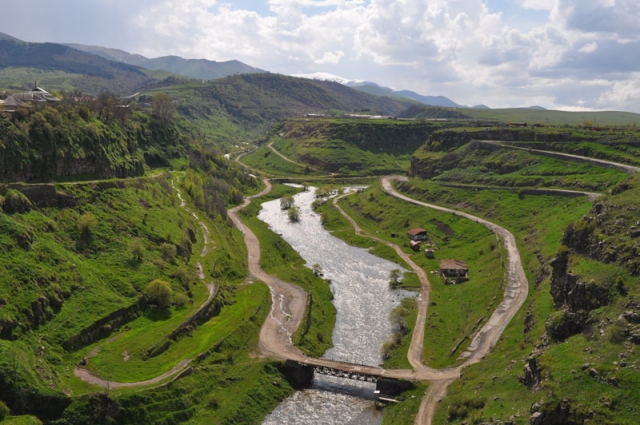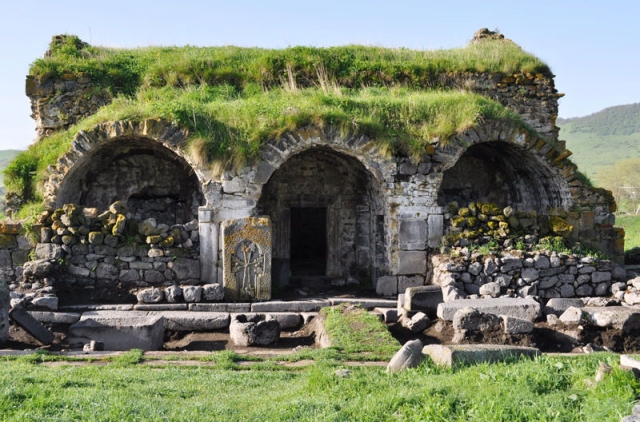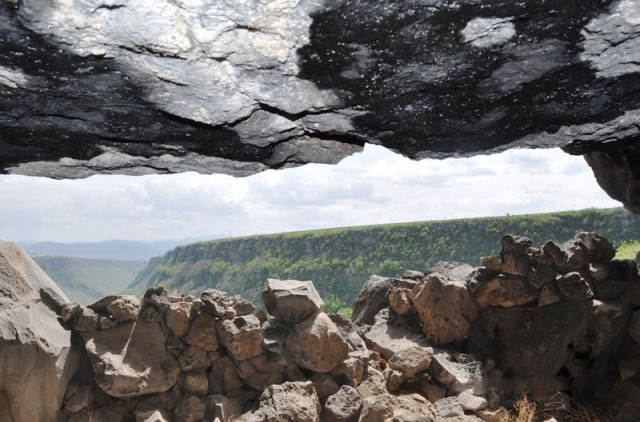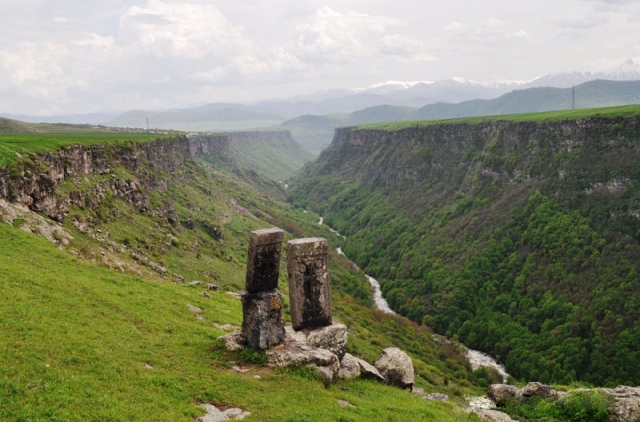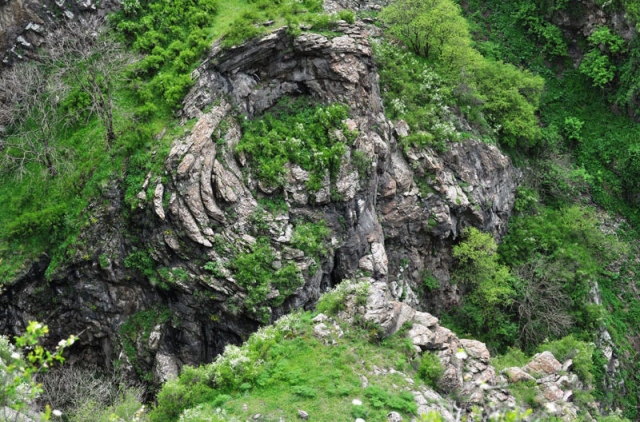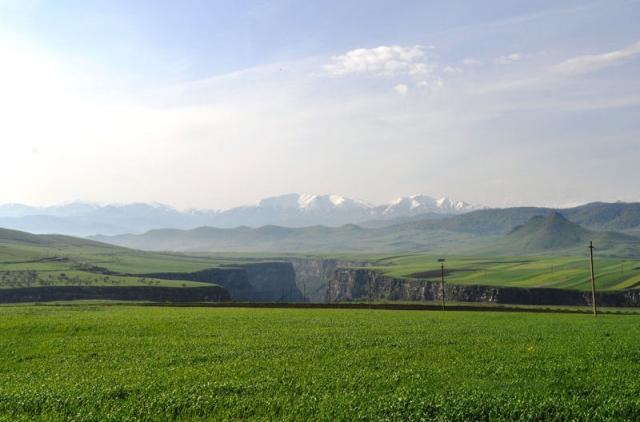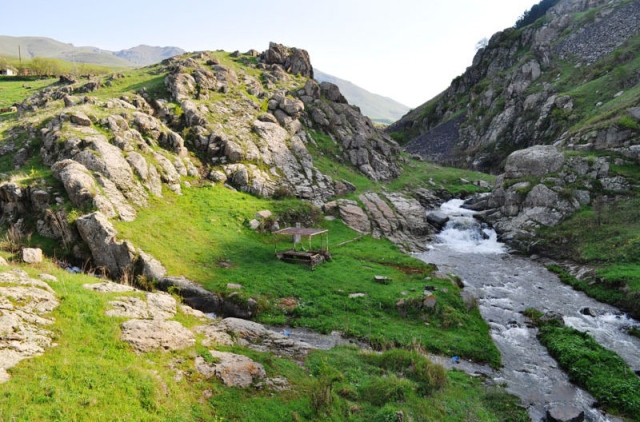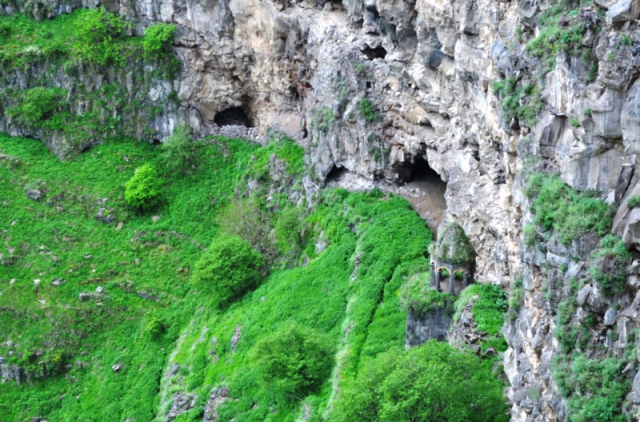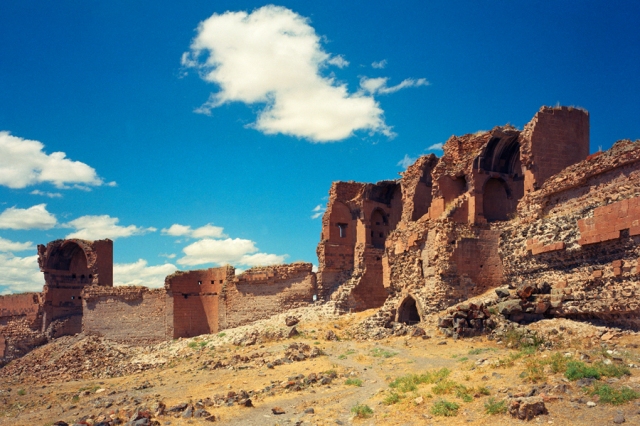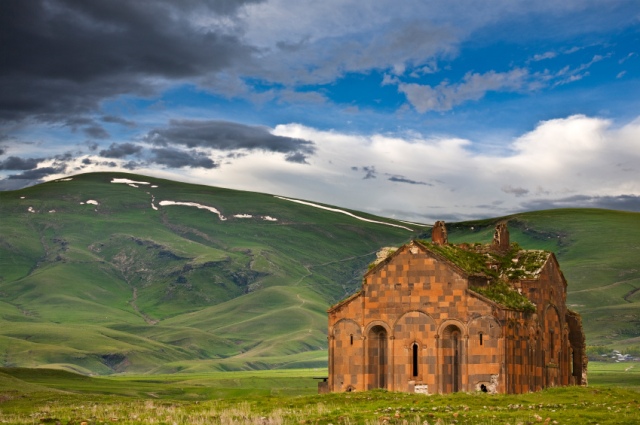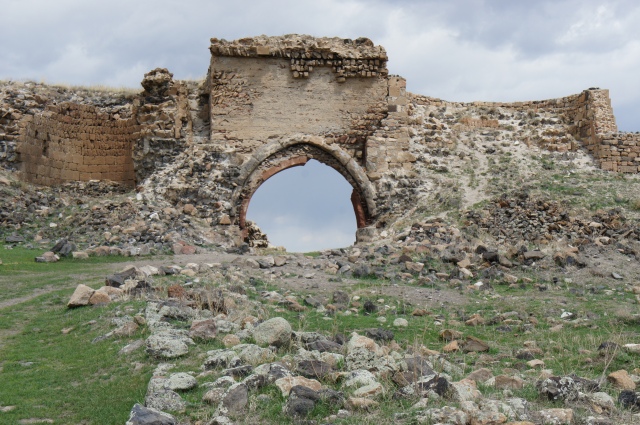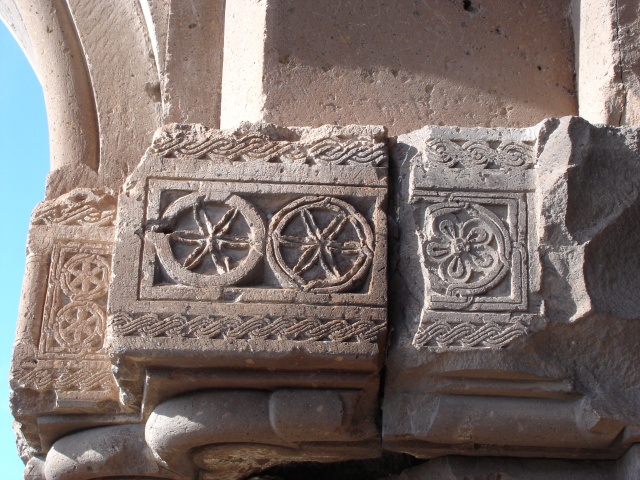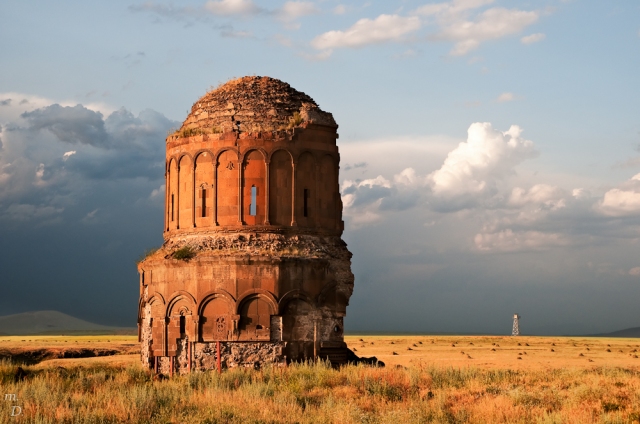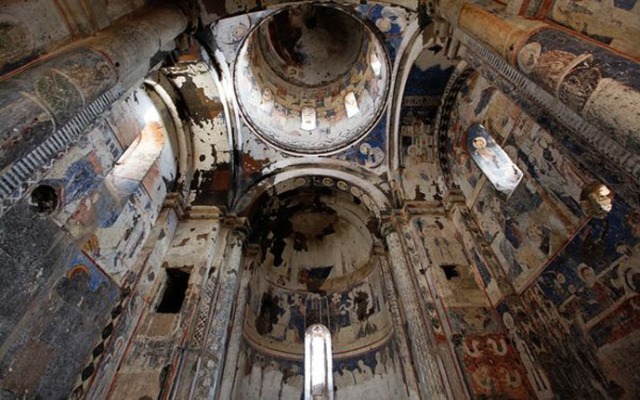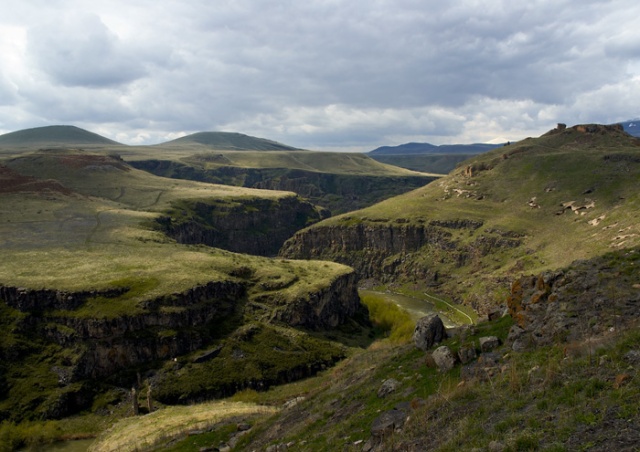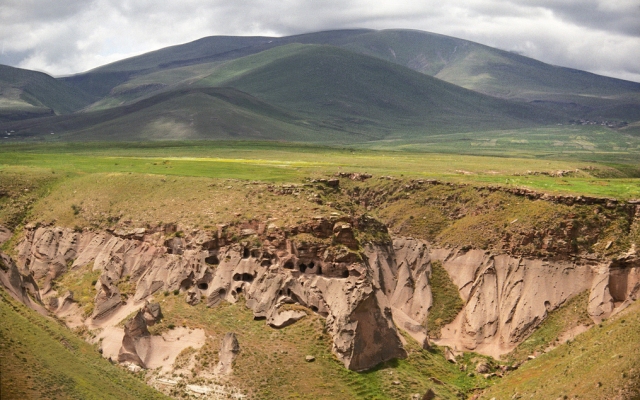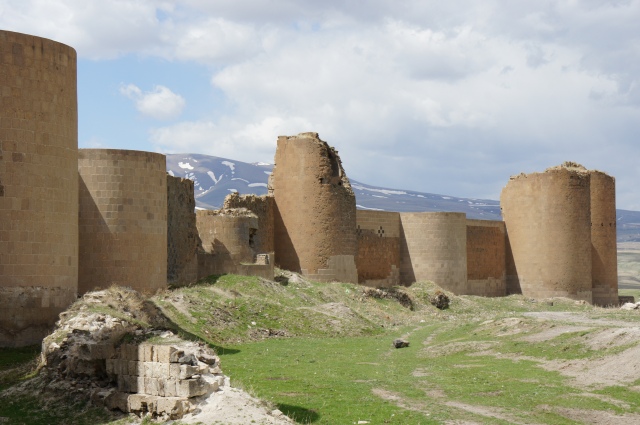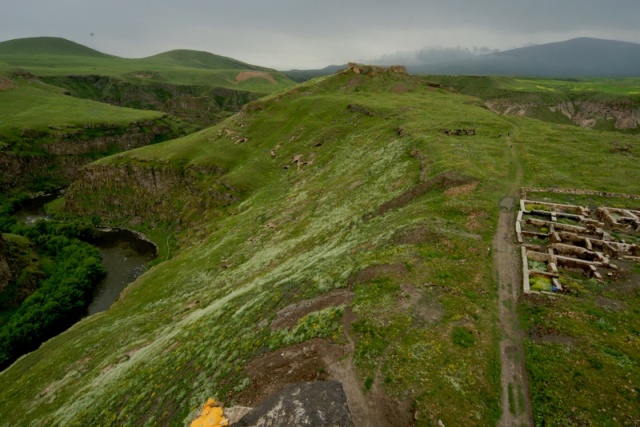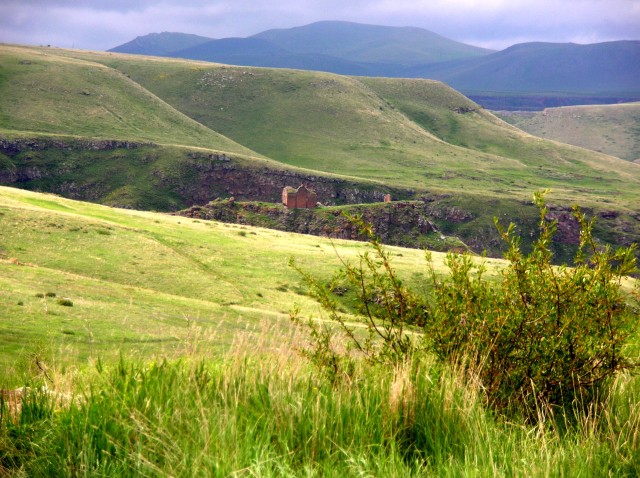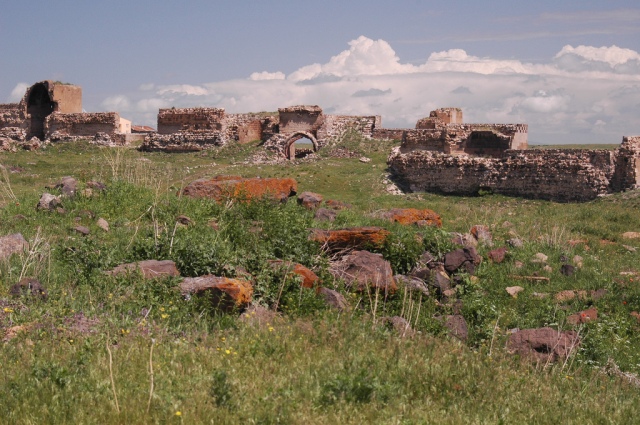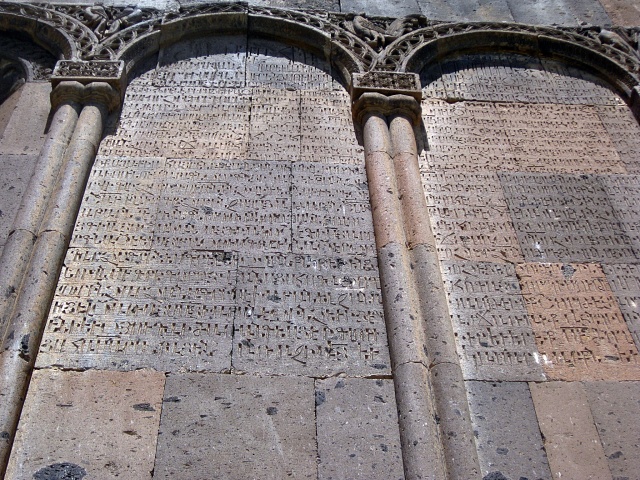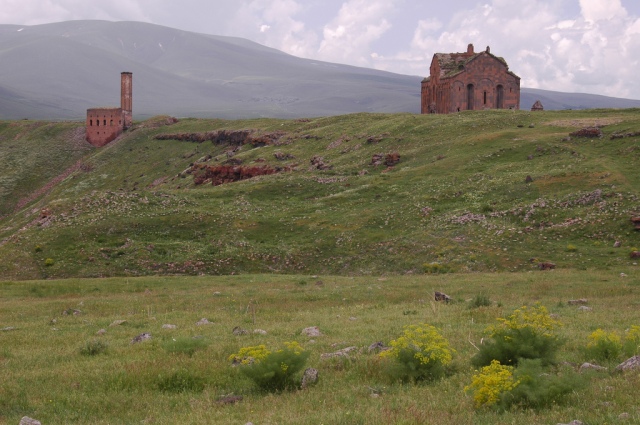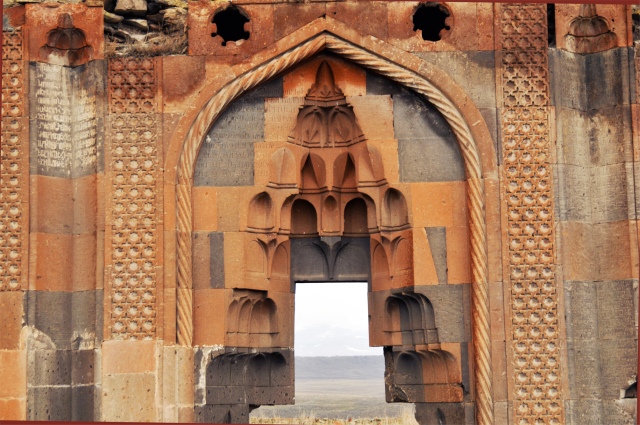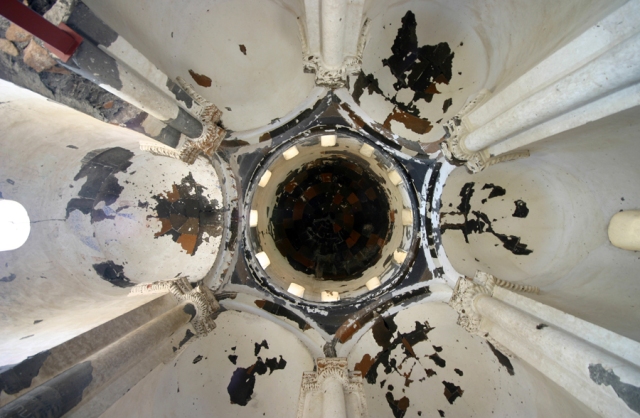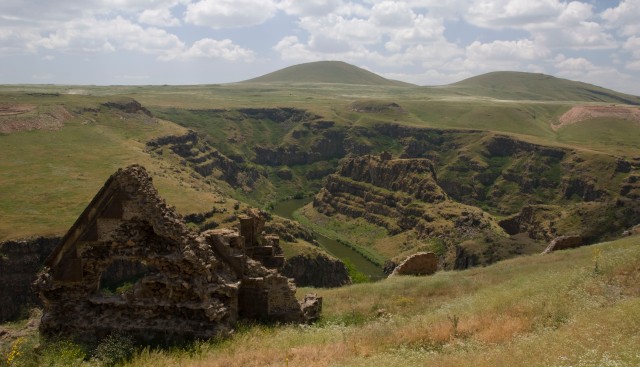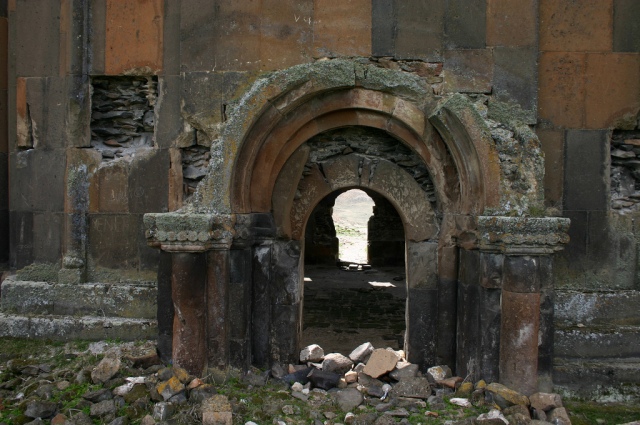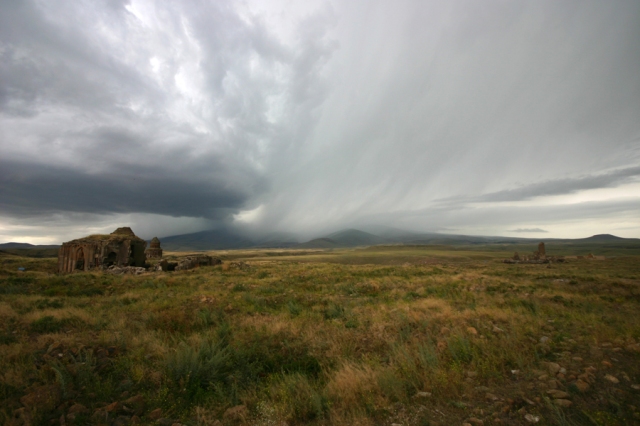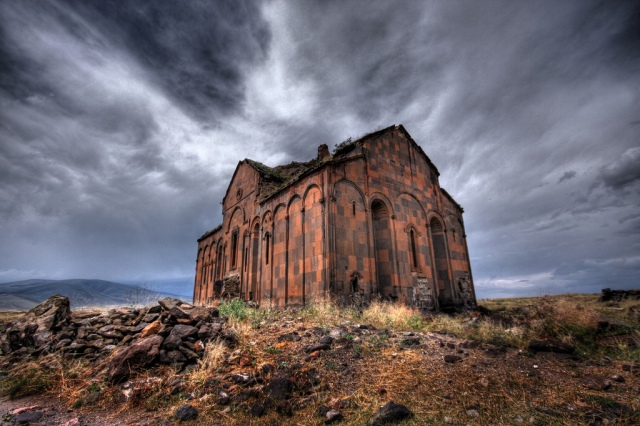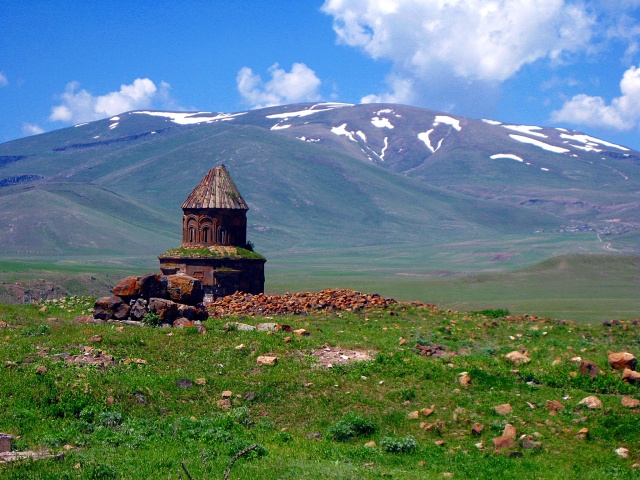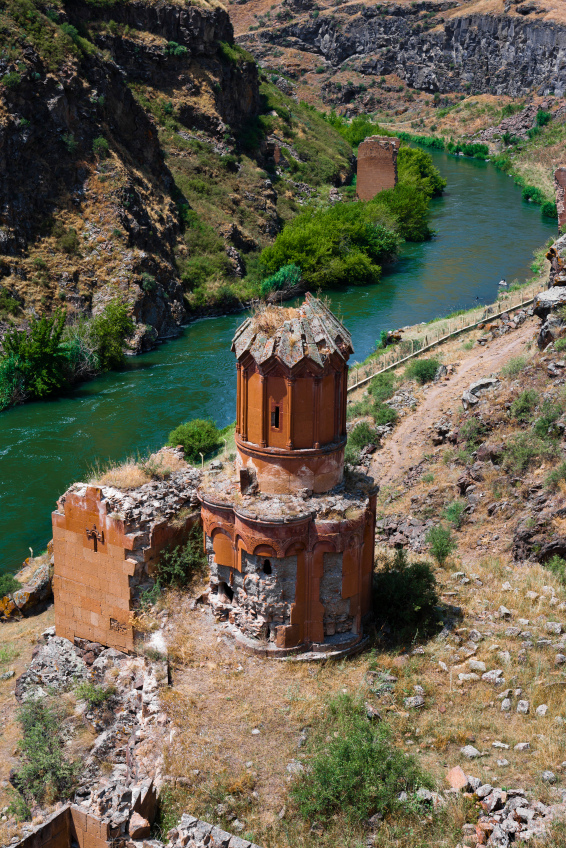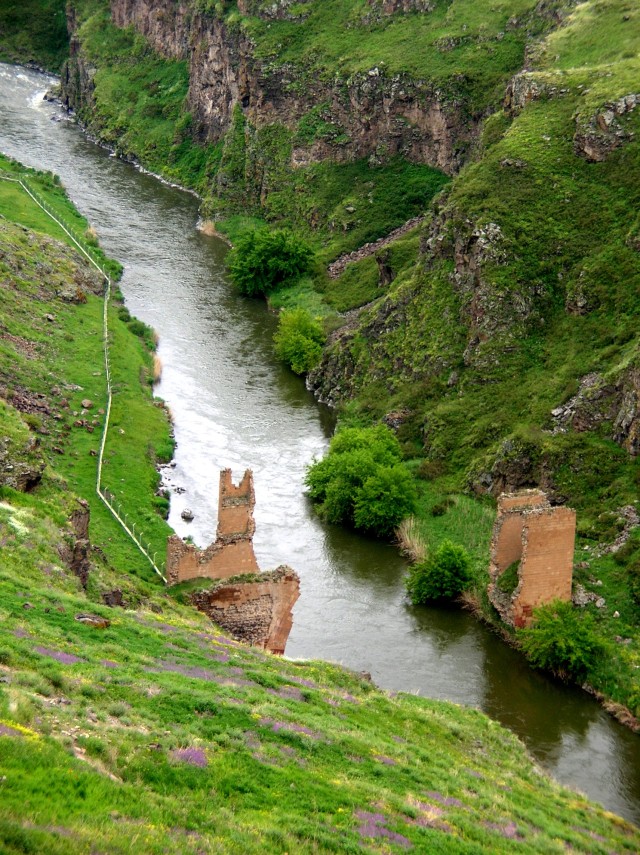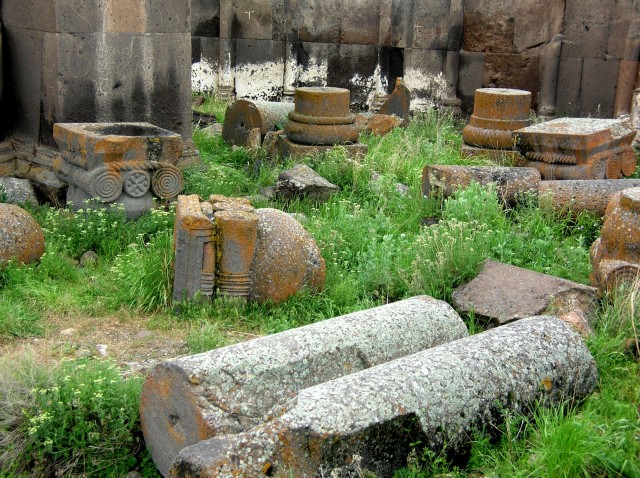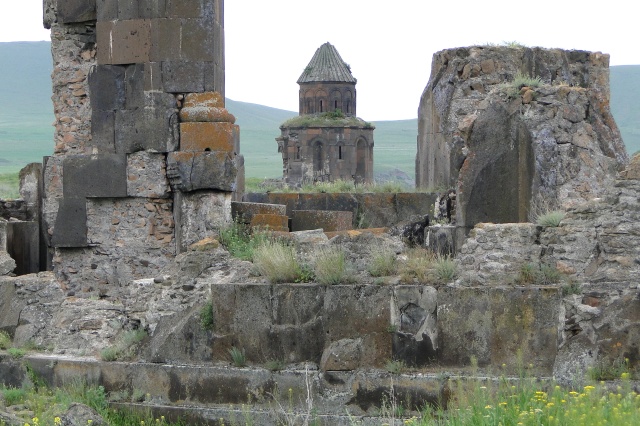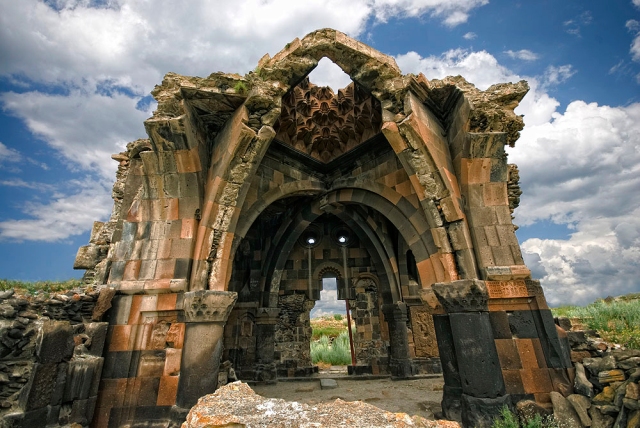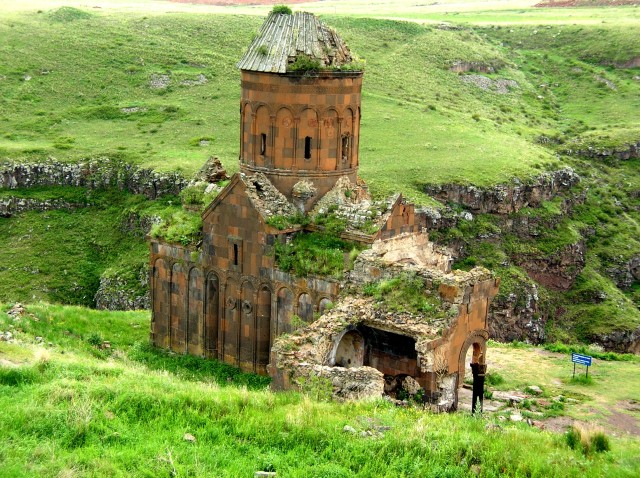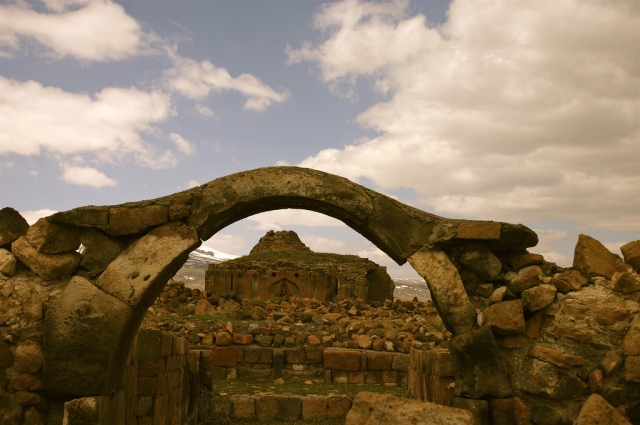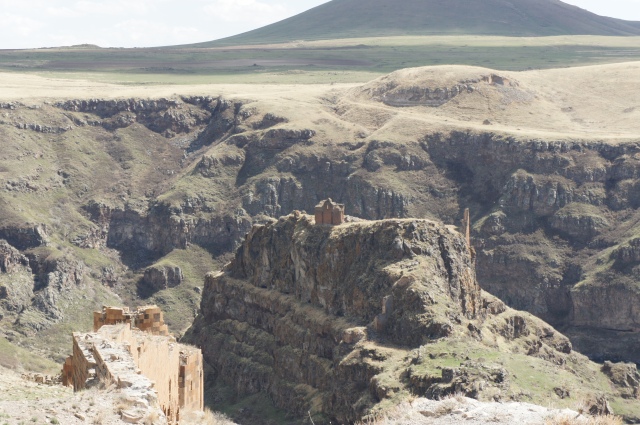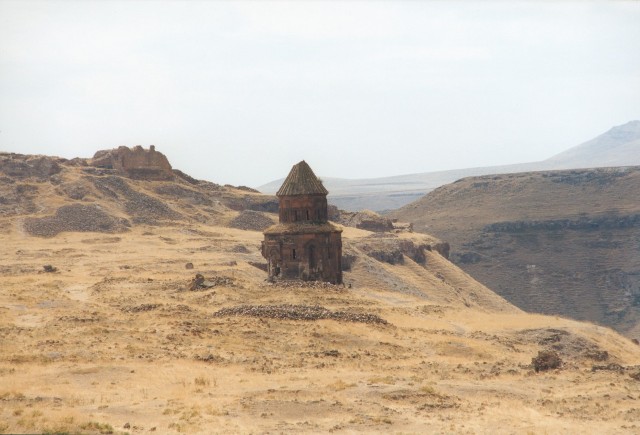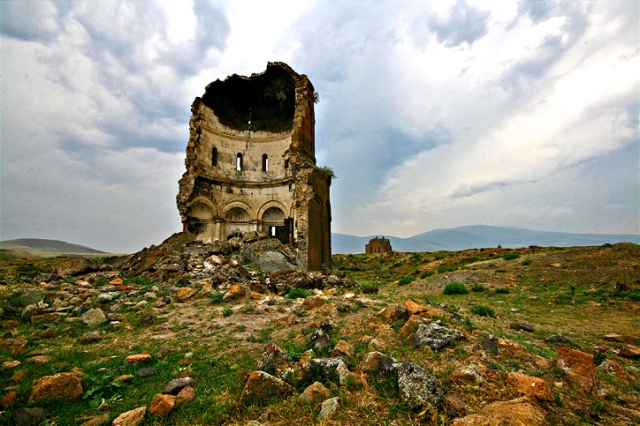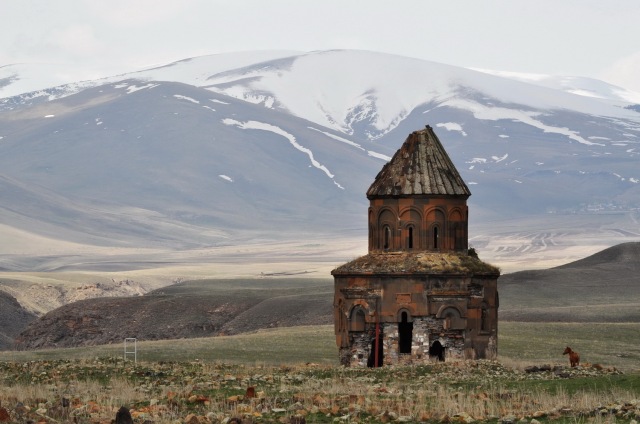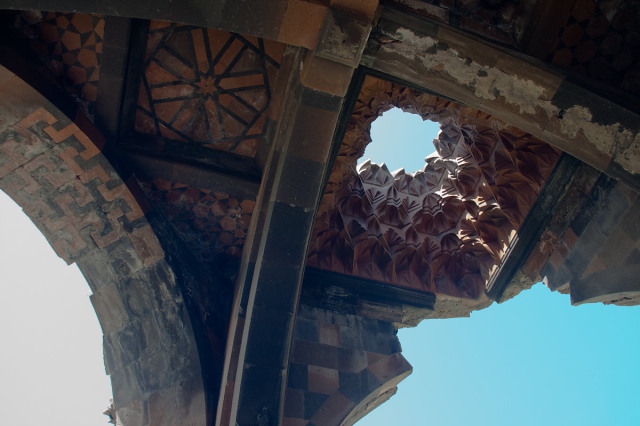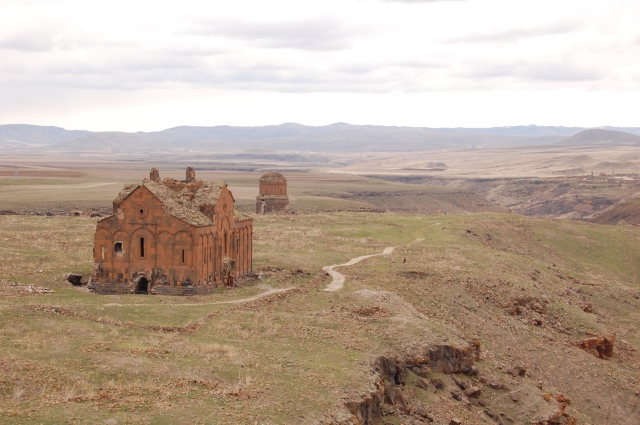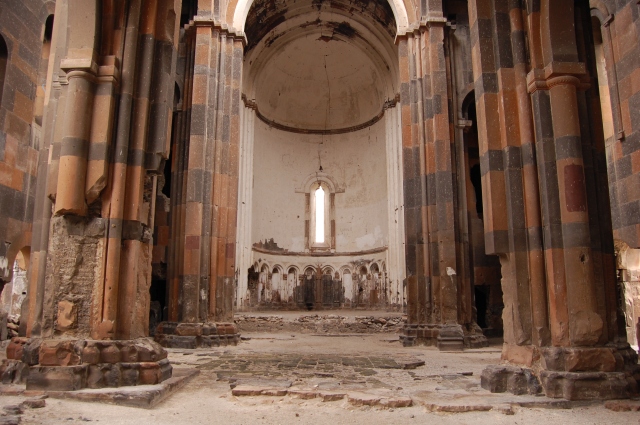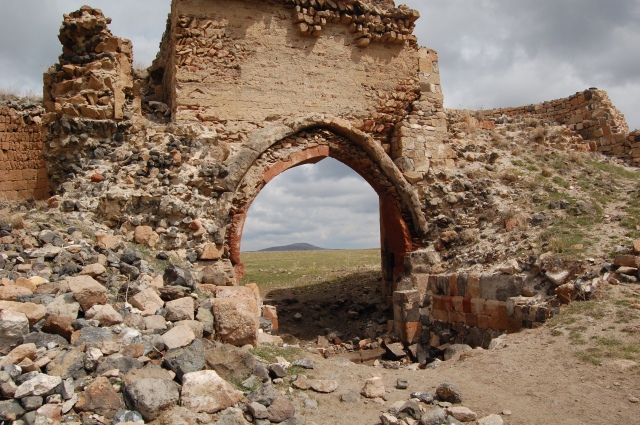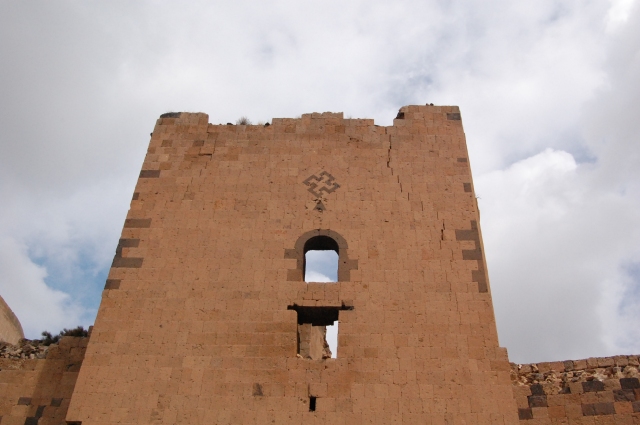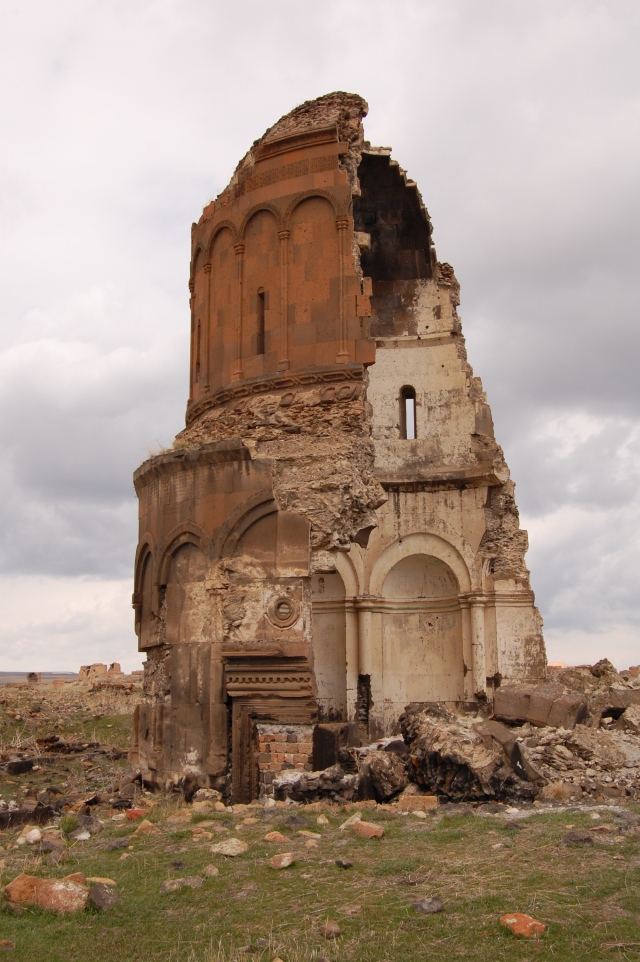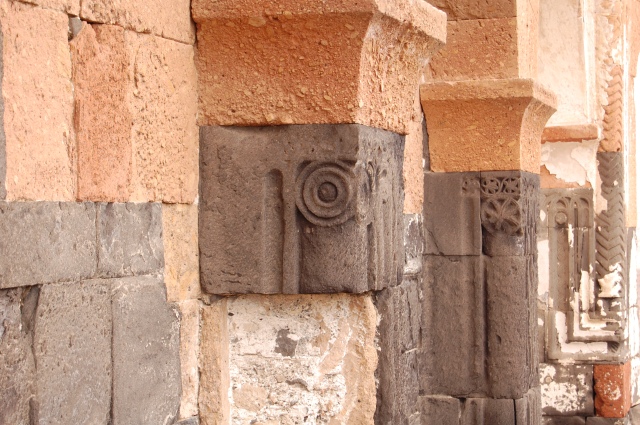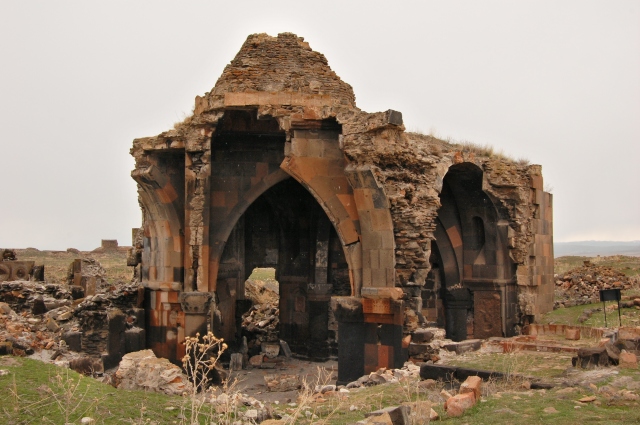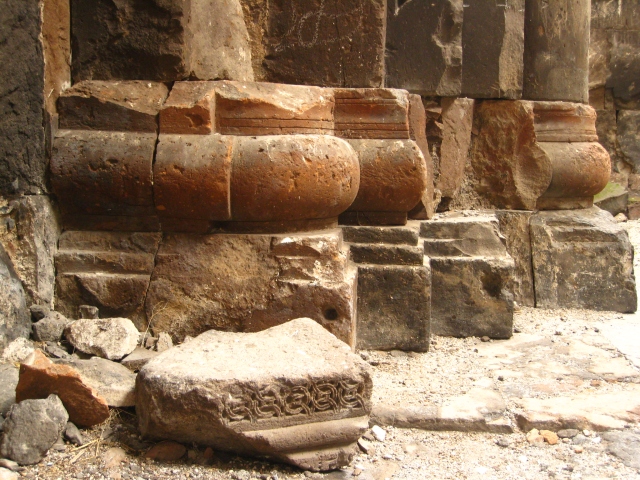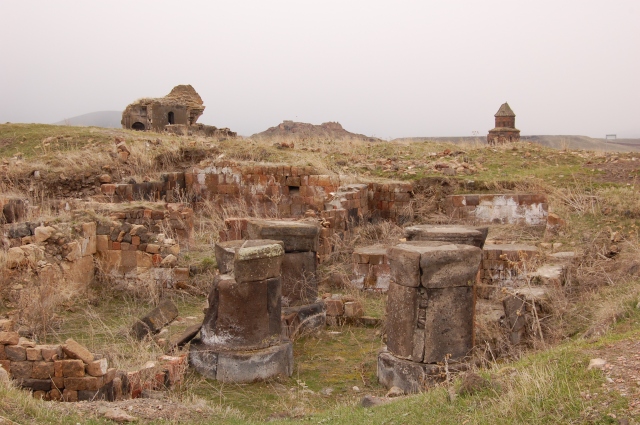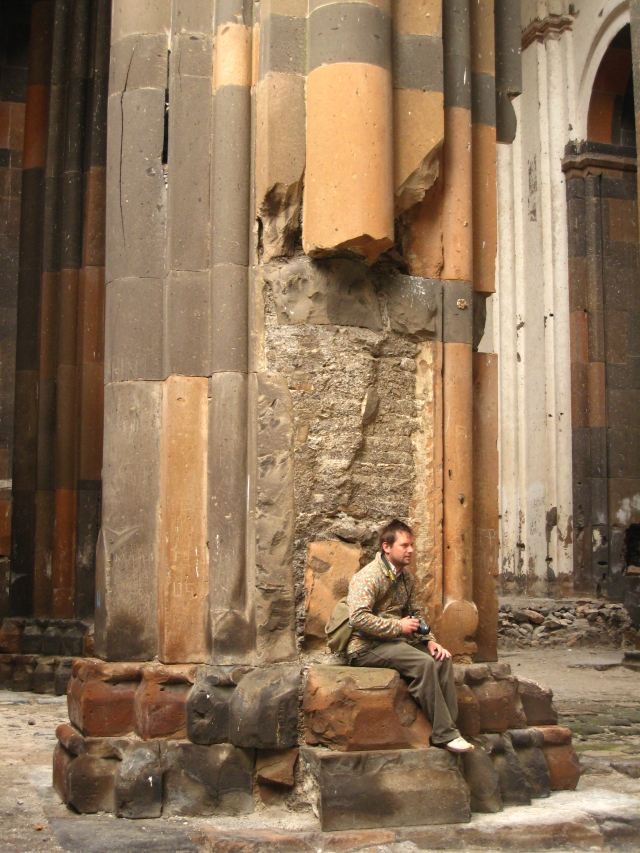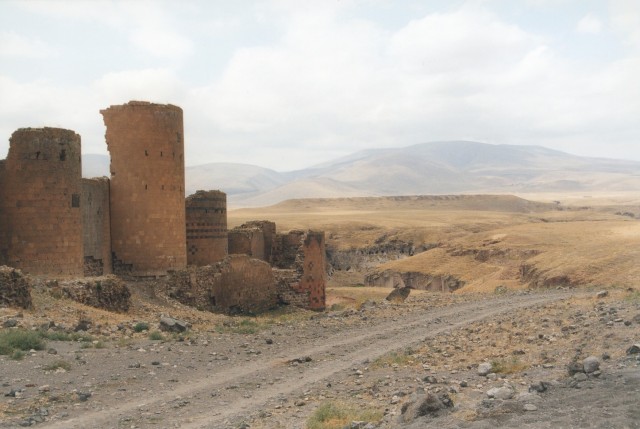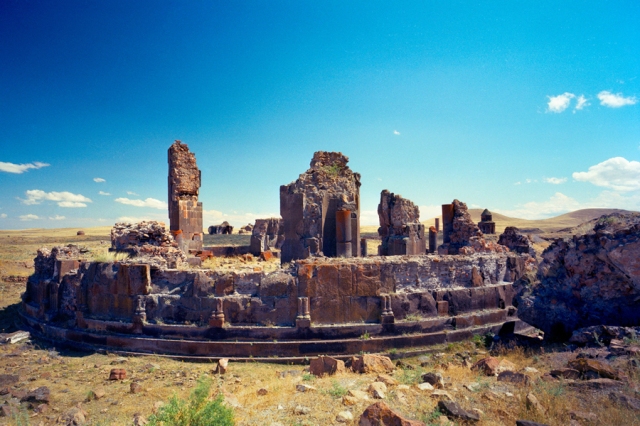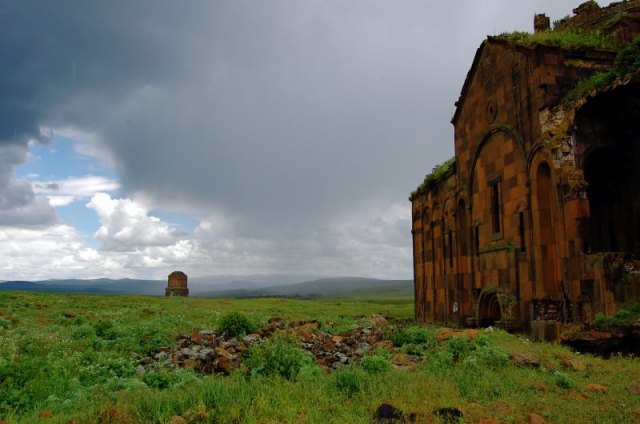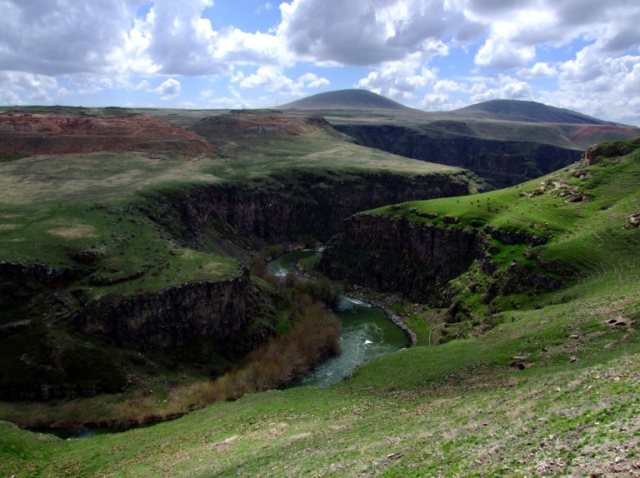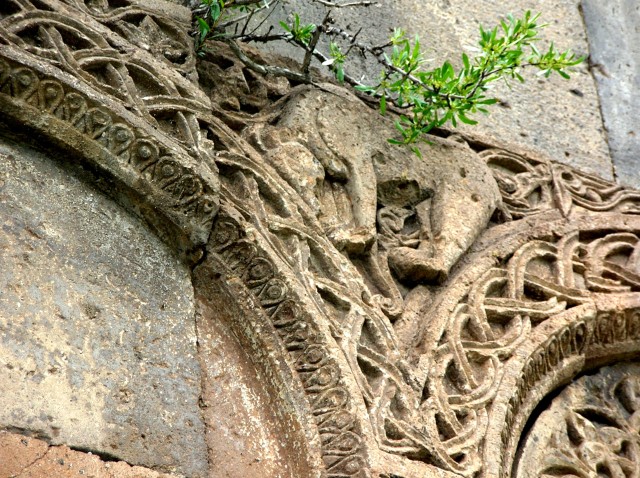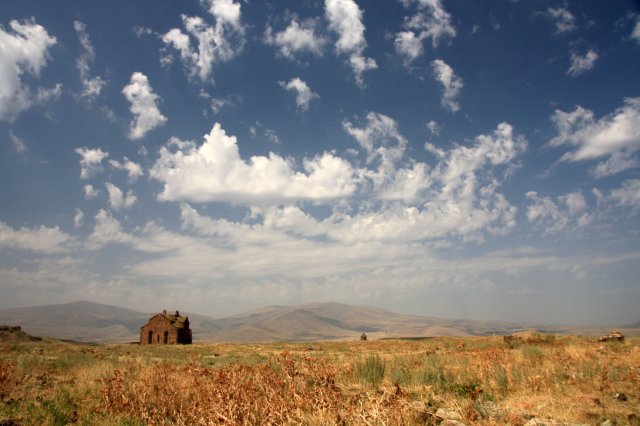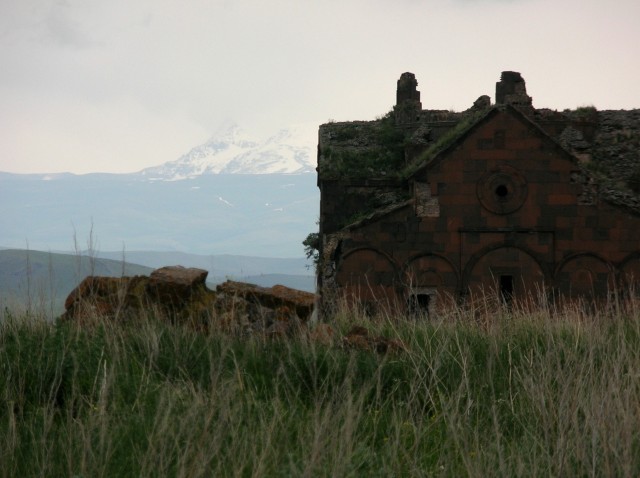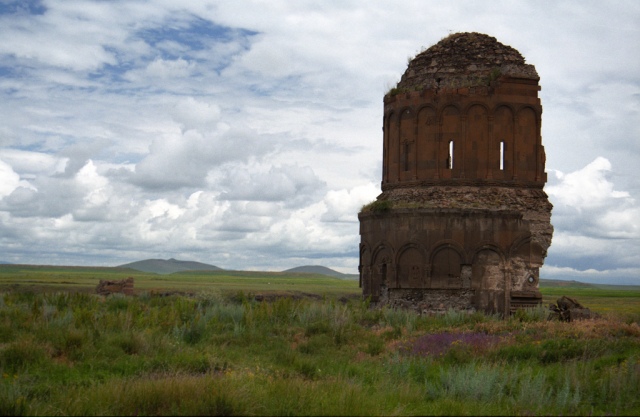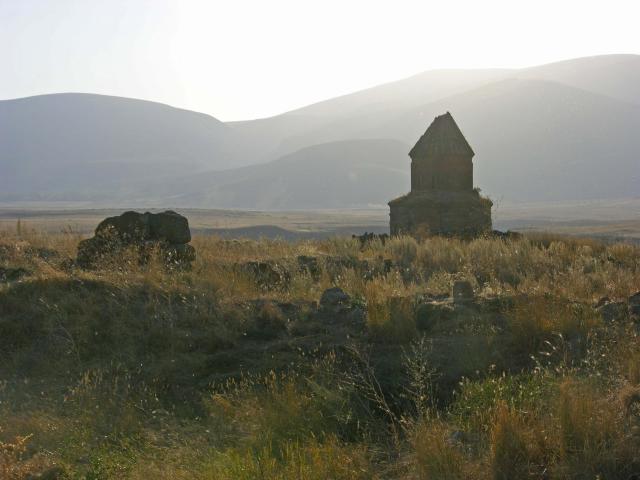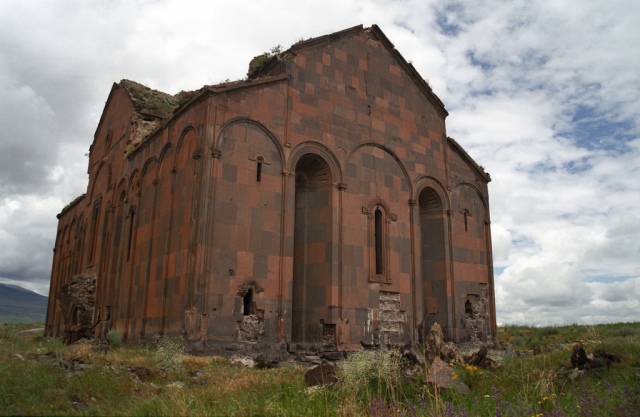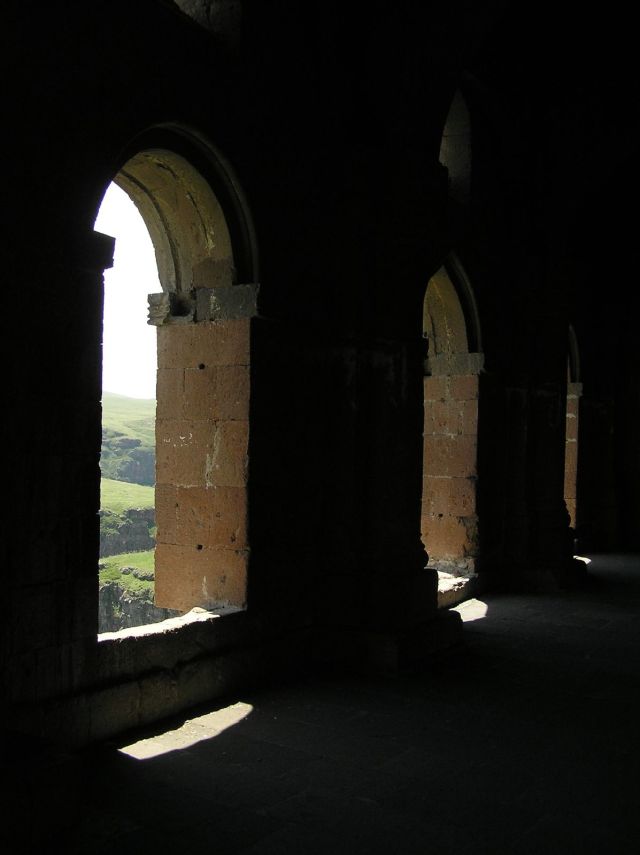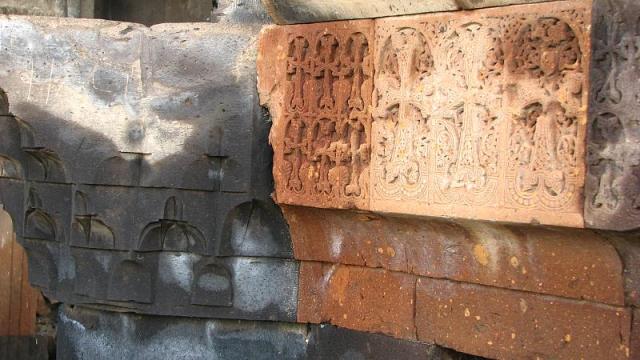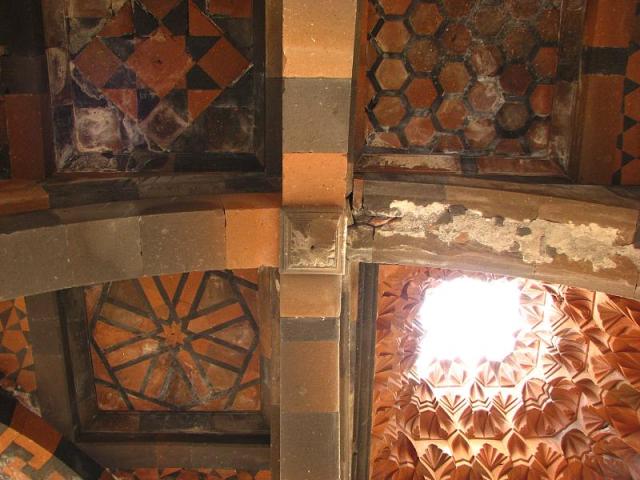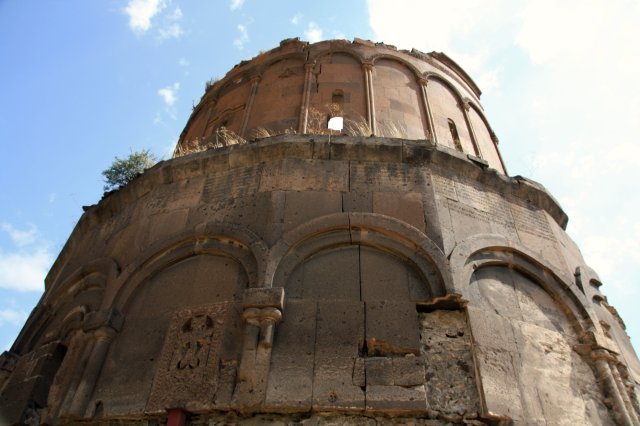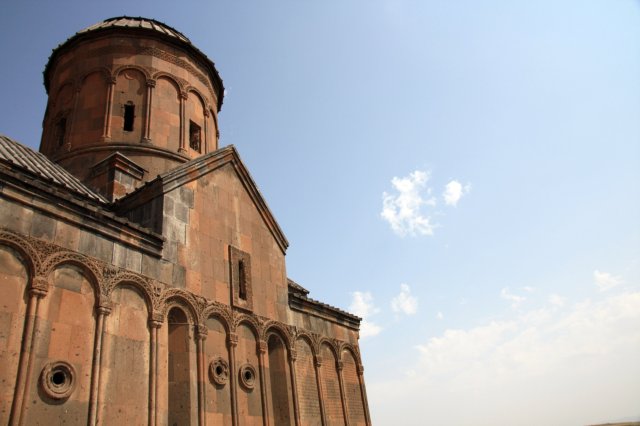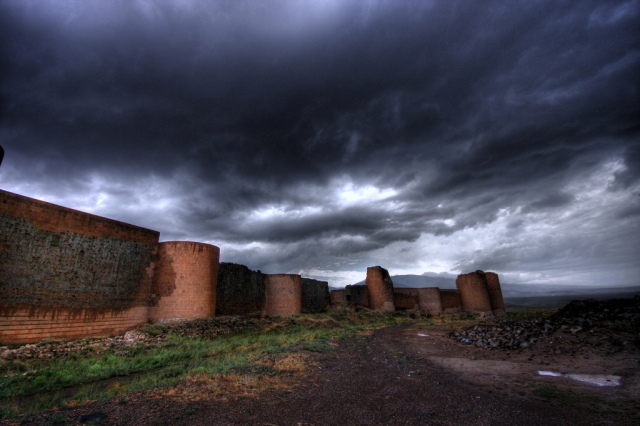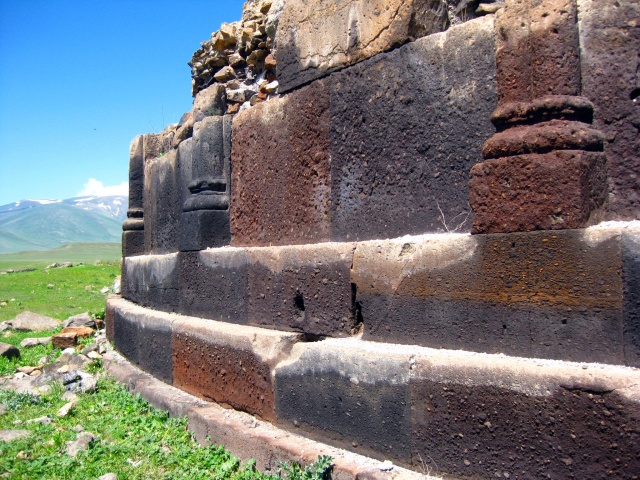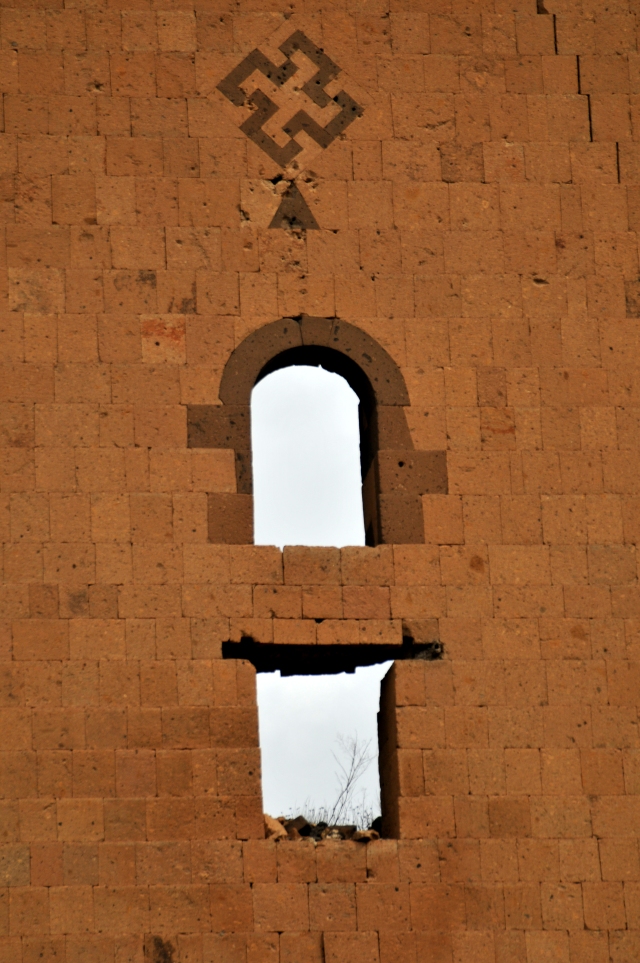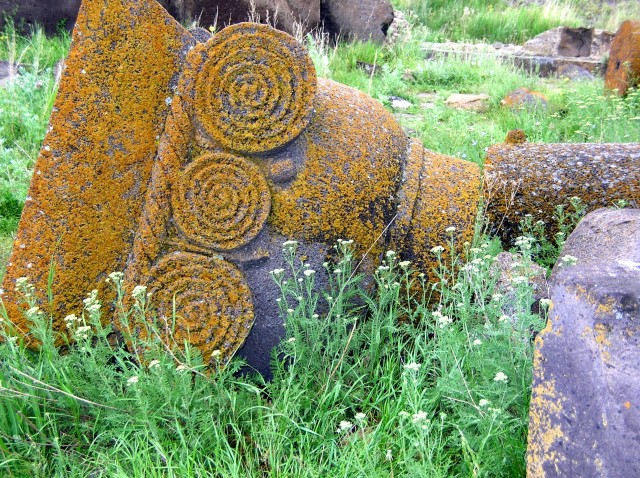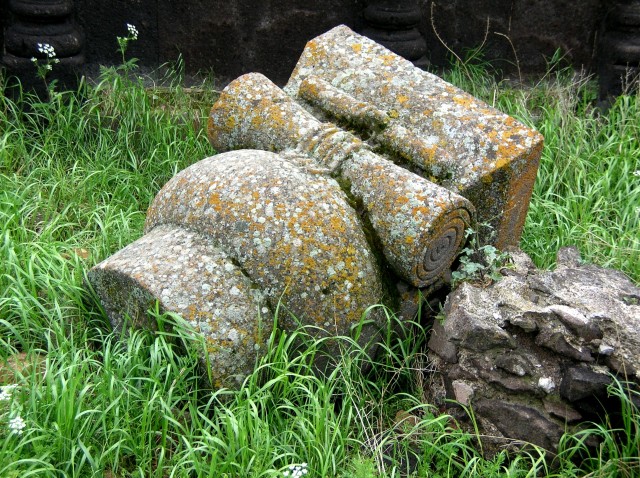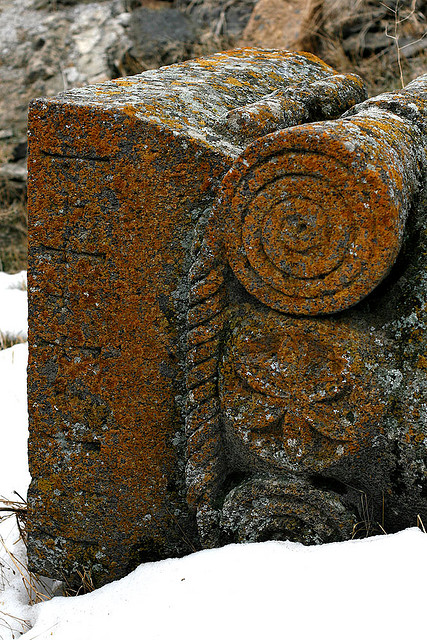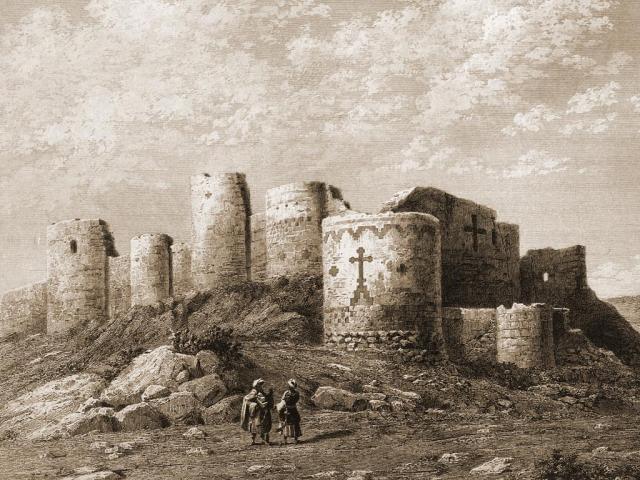![Walls of Ani]()
Some thousand years ago, the old Armenian capital Ani rivaled the likes of Constantinople, Baghdad and Cairo in size and influence. Historically Ani has been an Armenian settlement from the times immemorial. It is first mentioned in the 5th century Armenian chronicles as a strong castle built on a hilltop. Ani was made capital of the Bagratuni Kingdom in 961 AD. and by the 11th Century had grown to over one-hundred-thousand people. Renowned for its splendor and magnificence, Ani was known as “the city of 40 gates” and “the city of 1001 churches.” It would later become the battleground for various contending Empires, leading to its destruction and abandonment. Today Ani largely remains a forgotten ancient Armenian ghost town in modern day Turkey. Travelers, writers, and other adventurers through ages have described Ani with high regard. I think there is no better way to describe Ani but through the words of the people who have visited the site. Therefore bellow a selection of these heartwarming accounts.
Konstantin Paustovski a Russian Soviet writer, a Nobel prize nominee described Ani in 1923 with the following quotes:
“What is Ani like? There are things beyond description, no matter how hard you try.”
“On the other bank we saw basilicas, tiled Armenian domes and a complete absence of human beings. It was the ruins of the ancient Armenian capital, Ani – one of the real wonders of the world.”
![Cathedral of Ani]()
The British member of parliament and businessman H. F. B. Lynch in 1893 also describes the city of Ani in his book “Armenia, travels and studies.”:
“But a lesson of wider import, transcending the sphere of the history of architecture, may be derived from a visit to the capital of the Bagratid dynasty, and from the study of the living evidence of a vanished civilization which is lavished upon the traveller within her walls. Her monuments throw a strong light upon the character of the Armenian people, and they bring into pronouncement important features of Armenian history. They leave no doubt that this people may be included in the small number of races who have shown themselves susceptible of the highest culture.”
“The roofs as well as the walls are composed of stone, and, as usual in Armenian churches, no wood or metal has been used. Even at the present day the Armenian masons are possessed of exceptional skill; and their natural gifts have been here directed by the conceptions of genius.
The merits of the style are the diversity of its resources, the elegance of the ornament in low relief, the perfect execution of every part.”
“We admire these buildings in much the same state and condition as when they delighted the eyes of Armenian monarchs nine centuries ago. Such a site would in Western lands be at least occupied by a small town or village; the solitude of Ani is not shared by creations of a culture that has disappeared.”
![Church of the Redeemer, in Ani]()
Church of the Redeemer, in Ani
An Italian historian, traveler and diplomat Luigi Villari in 1905 recounts Ani as follows:
“We walked over one or two brown ridges, and suddenly the walls of Ani came in sight. There they stood, massive piles of masonry extending for nearly a mile, with huge round towers at short intervals, mute testimony to the deeds of the Armenians in the brave days of old.”
“Nowhere, except at Constantinople, have I seen more splendid defences of a mediaeval city. For about two-thirds of a mile they are still standing, and broken fragments of them extend along the whole length of the circumference of the city and descend into the ravine of the Arpa Chai.”
“The marvelous city shows evidence of a building power and architectural skill on the part of the ancient Armenians of the highest order, and enables us to realize that this people, in spite of the lamentable history of the last six centuries, is a nation with a noble past.
Today this spot, where proud kings once dwelt in splendid courts and held sway over prosperous lands and civilized subjects, where public life was active and vigorous, is a crying wilderness. None but the old priest and the peasant family dwell within the enclosure, and even the neighbouring country, formerly so fertile and well-peopled, is now almost uninhabited, and has become to a great extent barren desert. Is the state of Ani symbolical of that of the Armenian nation, and are they destined at last to disappear or be absorbed into other races, other religions? I do not think so, for with all the sufferings and persecution they have undergone they still preserve a vigorous national life. Many of them have been massacred, but the survivors are not absorbed. Their industry is more active than ever, and education is making great progress. They have built up the oil trade of Baku, they monopolize the commerce of Tiflis, and at Rostoff-on-the-Don, Baku, Odessa, Moscow, Kishinieff, Constantinople, Bombay, Calcutta, and many another city far removed from their ancestral homes, they form industrious, intelligent, and prosperous commercial communities. A people with such a past and such a present need surely not despair of its future.”
Little did Villari know that only 10 years after these words Armenians would endure maybe the darkest of days in their entire history. The horrible events of the Armenian Genocide. Yet almost prophetic his words came true when Armenians overcame even these horrendous events and today there is still such a country (albeit smaller than its historic territory) that is called Armenia.
![Ani Church decoration]()
Sir E. A. Wallis Budge, London 1928. recounts the visit of of Nestorian Christian monks Sawma and Markos to Ani in the 1270s:
“And when they arrived at the city of Animto (Ani) and saw the monasteries and the churches therein, they marvelled at the great extent of the buildings and at their magnificence.”
![Ani churh ruins]()
Yet another highly memorable quote comes from an English artist, author, diplomat and traveller Sir Robert Ker Porter in 1817:
“In the western extremity of this great town, in which no living beings except ourselves seemed breathing, we saw the palace, once of the kings of Armenia; and it is a building worthy the fame of this old capital. Its length stretches nearly the whole breadth between the walls of the city on one side, and the ravine on the other. Indeed, it seems a town in itself; and so superbly decorated within and without, that no description can give an adequate idea of the variety and richness, of the highly wrought carvings on the stone, which are all over the building; or of the finely-executed mosaic patterns, which beautify the floors of its countless halls.”
“The farther I went, and the closer I examined the remains of this vast capital, the greater was my admiration of its firm and finished masonry. In short, the masterly workmanship of the capitals of pillars, the nice carvings of the intricate ornaments, and arabesque friezes, surpassed anything of the kind I had ever seen, whether abroad, or in the most celebrated cathedrals of England.”
![Church of the redeemer from about 1040 AD.]()
Church of the redeemer from about 1040 AD.
William J. Hamilton in 1836 too described the outstanding building techniques of the Armenian craftsman, being able to build structures that would last for centuries. He describes:
“There was something impressive and almost awful in the sight of a Christian town, built in a style so peculiar to itself, and unknown to modern Europe, now nearly in the same state in which its destroyers had left it eight centuries ago.”
“There is hardly a building in Anni of any consequence which is not covered with Armenian inscriptions.”
![Church of Ani, st. Gregory of Tigran Honents]()
Church of Ani, st. Gregory of Tigran Honents
Foreign travelers are not the only once to have recorded Ani in such regard. Armenians who have visited the site of the ancient abandoned Armenian capital often had a hard time holding back their emotions. Basmadjian in 1903 describes the sites as follows:
“The traveler or the pilgrim, whether coming by horseback, by carriage, or even on foot, before arriving at this city in mourning, looks towards the site with a thousand thoughts. He is impatient; he strains to see it – even for just a moment – from afar, one doesn’t know if it is to feel an inner contentment or to satisfy the longings of many years. It is a powerful feeling, an unexplainable desire, that burns, that strains at the hearts of all Armenians and even those of foreign travellers.
And then your companions cry out “ANI!” It is as if a bomb had suddenly exploded, or an electrical current had crossed your body! You tremble; the regular flow of your breathing is altered; your heart pounds; your nerves soften; you are filled with emotions and your eyes begin to moisten with tears; you are no longer your own master; the tears that you initially held back you now allow to flow, to pour down your cheeks. You cry like a child, in front of these crumbling walls, these half destroyed buildings, these heaps of moss covered stones that awaken old and powerful memories in you.”
![Ancient Armenian capital Ani]()
British army officer Major-General Charles Gordon in his letter describes an account of his visit to Ani in the year 1857:
“The third day of our tour we passed through Ani the ancient capital of Armenia. This city is completely deserted, and has splendid churches still standing in it. These churches are capitally built and preserved. Some coloured drawings on their walls are to be seen even now. I have obtained some views for you from this interesting place. The towers and walls are almost intact; but the most extraordinary thing about so large a place is the singular quietness.
I feel myself unable to describe this extraordinary place as it ought to be done.”
![Ancient cave dwellings of Ani]()
Ancient cave dwellings of Ani
Baron Max von Thielmann (1872) in his book ‘Journey in the Caucasus, Persia, and Turkey In Asia’ describes seeing Ani and its marvelous architecture that at “some parts are as fresh-looking as if they were only completed yesterday.” He further describes the sensation of being at the site as follows:
“On reaching a gentle ridge extending between two hills some 200 feet in height (near Kara-Kala in the Five Verst Map), a panorama disclosed itself to our gaze, which for wild and desolate grandeur is perhaps unparalleled. Before us lay extended a rocky plain about five miles in length, and at its further extremity was a mighty city, surrounded by walls with towers, churches and palaces – a noble pile, but devoid of animation.
The associations aroused by this scene were enhanced a thousand-fold by the tranquility and desolation which prevailed; for in days gone by the capital of a mighty empire had stood on this very spot in full glory and magnificence; and so intense was the impression occasioned by this solitude amongst ruins, that, even later on at Babylon and at Palmyra, I did not experience so acute a sensation.”
![City walls of Ani]()
William of Rubruck in the account of his visit to Ani in 1255 states:
“On the feast of the Purifaction I was in a city called Ani. Its population is extremely strong: it contains a thousand Armenian churches…”
Bellow some more images of the abandoned ancient capital of Armenia:
![Ani city]()
![Ani ruins - view toward Armenia]()
Ani ruins – view toward Armenia
![Ancient Armenian capitol Ani]()
![Armenian city Ani]()
![Armenian script on ancient city Ani]()
![Armenian city Ani cathedral]()
![Ani walls Armenian]()
![Armenian cathedral dome of Ani]()
![Ani Armenian city]()
![Ruins of a Church in Ani]()
![Armenian old capital]()
![Cathedral of Ani ancient Armenia]()
![Church in Ani]()
![Bridge in Ani ancient Armenia]()
![Ani bridge ruin between Turkey and Armenia]()
![Church of St. Gregory built in 1001iii]()
Church of St. Gregory built in 1001
![Ruins with Church at Rear - Ani (Ancient Armenian Capital) - Near Kars - Turkey]()
Ruins with Church at Rear – Ani (Ancient Armenian Capital) – Near Kars – Turkey
![Church in Ani capital of Armenia]()
![Ani Church of St Gregory (1215)]()
Ani Church of St Gregory (1215)
![Armenian church in Ani]()
![Armenian castle of Ani]()
![Armenian city Ani]()
![Armenian church Ani]()
![Armenian medieval church of Ani]()
![Holy Apostles church of Ani]()
Holy Apostles church of Ani
![Medieval Armenian Cathedral of Ani view]()
![Medieval Armenian Cathedral of Ani]()
![Ani city walls]()
![Tower of Ani]()
![Armenian church in Ani]()
![Wall decorations of Armenian city of Ani]()
![Armenian church]()
![Collumns decorations of ancient Armenian church]()
![Ruins of ancient Armenian city Ani]()
![taking pictures in Ani Armenian church]()
![Ani townwall]()
![Ruins of Ani church]()
![Ani church]()
![Armenian Border in Ani]()
![Ani Church of St Gregory (1215)ko]()
![Medieval Armenian city Ani]()
![Caves of Ani]()
![Ani cathedral with Armenia's Little Ararat in background]()
![Church of the Redeemer, Ani]()
![Church in Ani, medieval Armenia]()
![Cathedral of Ani]()
![Ani tower]()
![Ani city of Bagratid Armenia]()
![Ani city of Bagratid Armenia]()
![Armenian Cross stones in Ani]()
![Ceiling of Armenian church in Ani]()
![Armenian church]()
![Old Armenian church]()
![Ani wall]()
![4611518855_c5e5415df4_o]()
![6041241228_c6f8e4d847_o]()
![Church of St. Gregory built in 1001]()
Church of St. Gregory built in 1001
![Church of St. Gregory built in 1001 Church of St. Gregory built in 1001]()
Church of St. Gregory built in 1001
![Ornamental stones of a ruined Armenian church in Ani]()
Ornamental stones of a ruined Armenian church in Ani
![Drawing of Ani, medieval Armenia]()
Sources:
http://www.virtualani.org/
http://armenianhouse.org/villari/caucasus/alexandropol-ani.html
![]()
![]()













































